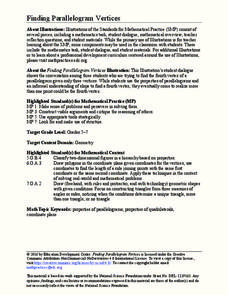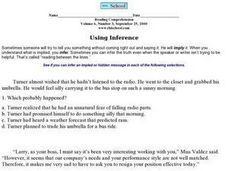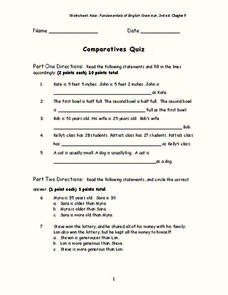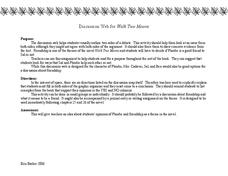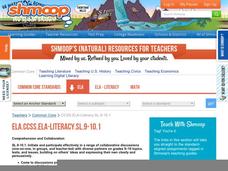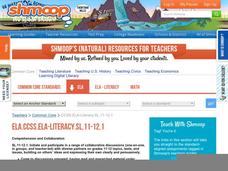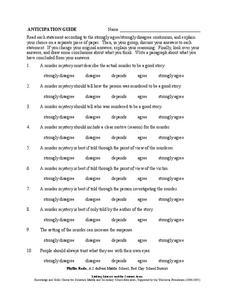Education Development Center
Finding Parallelogram Vertices
Four is the perfect number—if you're talking about parallelograms. Scholars determine a possible fourth vertex of a parallelogram in the coordinate plane given the coordinates of three vertices. They read a conversation...
Noyce Foundation
Boxes
Teach your class to think outside the box. Scholars use the concept of equality to solve a problem in the assessment task. They determine how to use a scale to identify the one box out of a set of nine boxes that is heavier than the others.
Texas State Energy Conservation Office
Investigation: Kinetic and Potential Energy
A well-developed lab sheet guides physical science learners through an investigation of kinetic and potential energy. In small groups, collaborators discover whether or not the ramp height or mass of an object has an effect on the...
Classroom Law Project
What does the Constitution say about voting? Constitutional Amendments and the Electoral College
As part of a study of voting rights in the US, class members examine Constitutional amendments connected with voting and the role of the Electoral College in the election process.
California Education Partners
Science Fair Project
Plant the data firmly on the graph. Given information about the growth rate of plants, pupils determine the heights at specific times and graph the data. Using the information, scholars determine whether a statement is true and support...
Curated OER
Using Inference
In this using inference worksheet, students select implied conclusion responses, for 4 multiple choice questions, based on the events presented in the short reading passages.
Curated OER
Inferences i: Pretest
In this inferences instructional activity, students answer multiple choice questions about inferences after reading passages. Students answer 6 questions total.
Curated OER
Paper Airplanes and Scientific Methods
In this scientific method and paper airplanes worksheet, students go through the steps of the scientific method to determine which paper airplane design is best. They complete 8 steps of the scientific method including stating the...
Curated OER
Chain Letters and Pyramid Schemes
In this statistics lesson, students analyze chain letters and draw conclusions of the outrageous amount of letters that would be mailed out if people really followed through. This is more of a thought provoking worksheet than problem...
Education Development Center
Finding Triangle Vertices
Where in the world (or at least in the coordinate plane) is the third vertex? Given two coordinate points for the vertices of a triangle, individuals find the location of the third vertex. They read an account of fictional...
Curated OER
Scientific Method
In this Scientific Method worksheet, students identify controls and variables given hypothetical situations taking place in Bikini Bottom. Students draw conclusions form the information they gathered in the experiments.
Curated OER
Comparatives Quiz
In this language arts assessment worksheet, students complete a 32 question quiz that includes sentence writing, comparatives, reasoning and drawing conclusions.
Curated OER
Designing a Speedometer
In this algebra worksheet, students analyze the designs of a speedometer. They collect data on the distance and time as the speedometer works. They draw conclusion and make predictions from the collected data. There are 4 word problems.
Curated OER
Walk Two Moons: Discussion Web
Is Phoebe a good friend to Sal or not? After reading chapters twenty-five and twenty-six of Walk Two Moons, class members use the provided graphic organizer to develop an argumentative piece. Writers must decide if the two main...
Inside Mathematics
Archery
Put the better archer in a box. The performance task has pupils compare the performance of two archers using box-and-whisker plots. The resource includes sample responses that are useful in comparing individuals' work to others.
Noyce Foundation
Ducklings
The class gets their mean and median all in a row with an assessment task that uses a population of ducklings to work with data displays and measures of central tendency. Pupils create a frequency chart and calculate the mean and median....
Shmoop
ELA.CCSS.ELA-Literacy.SL.9-10.1
Translate the first speaking and listening standard for yourself and your ninth and tenth graders! Learners can focus on communicating in small groups with the two activities presented here. Both activities center around group creation...
Balanced Assessment
Movie Survey
Movie preferences will get your classes talking! Individuals read a pie graph and construct a bar graph using the same information. They then answer questions specific to the data and sample size.
Shmoop
ELA.CCSS.ELA-Literacy.SL.11-12.1
You want your class to meet all of the Common Core standards, and here is one way to tackle the first speaking and listening standard. Given a theme to focus on from "How Much Land Does a Man Need?" by Leo Tolstoy, small groups come up...
Inside Mathematics
Quadrilaterals
What figure is formed by connecting the midpoints of the sides of a quadrilateral? The geometry assessment task has class members work through the process of determining the figure inscribed in a quadrilateral. Pupils use geometric...
California Education Partners
Improving Our Schools
Split the work three ways. Learners use their knowledge of fractions to solve problems dealing with splitting up work loads evenly between three groups. Scholars determine the fractional portion of work each group will do along with...
Curated OER
Comprehension Questions for Black Like Kyra White Like Me
In this comprehension questions for Black Like Kyra White Like Me worksheet, students read the book then answer 20 comprehension questions about it.
Curated OER
Anticipation Guide
Young readers consider ten questions regarding murder mystery stories. The must choose from one of five options: strongly disagree, disagree, depends, agree, or strongly agree. A sample questions is, "A murder mystery must describe the...
Curated OER
School-Home Links/ Book Links
In this recognizing the main idea worksheet, students read a book, record the title and author, state the main idea, explain what the author wants them to think about the main idea, and tell how they know. Students write five answers.


